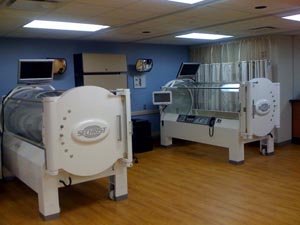 |
The two newest hyperbaric oxygen chambers in Birmingham are up and running in the new Wound Care and Hyperbaric Medicine Program clinic at UAB Hospital. The clinic, which formally opened on Aug. 27, 2012, provides hyperbaric treatment for chronic wounds that won’t heal or for infected acute wounds following surgical procedures. It is the only hyperbaric chamber facility in Birmingham to offer around-the-clock emergency care.
Hyperbaric chambers increase the pressure around a patient while they breath, causing more oxygen saturation in the bloodstream. They have long been used for treating decompression injuries, known as “the bends,” in deep-sea divers.
Oxygen saturation is also a catalyst in wound healing and hyperbaric chambers are used in a variety of medical situations. Chronic wounds that resist healing, often related to vascular insufficiency or diabetes, are the most common application. The chambers are also used to treat acute carbon dioxide poisoning, and air or gas embolisms, which can occur during surgery or other medical procedures. Radiation-damaged tissue, burns and trauma patients, as well as those with vascular disease, may also be treated in hyperbaric chambers.
“We typically see chronic wounds, especially in the feet or lower leg, in patients with poor circulation or diabetes,” says Keith Knight, manager of the UAB wound care program. “Wounds must have sufficient oxygen to heal, as it promotes new tissue growth and angiogenesis, the process of growing new blood vessels in damaged tissue.”
| The new Wound Care and Hyperbaric Medicine Program clinic at UAB Hospital provides hyperbaric treatment for chronic wounds that won’t heal or for infected acute wounds following surgical procedures. It is the only hyperbaric chamber facility in Birmingham to offer around-the-clock emergency care. |
During treatment, the patient simply lies down in the chamber while the pressure is increased up to three atmospheres. Patients can communicate with technicians via an intercom system, watch TV or sleep while undergoing treatment.
Treatment for chronic wounds typically consists of multiple treatments (up to 30 or more) for two hours at a time, five days a week. A single treatment is usually sufficient for some acute problems such as decompression sickness and air or gas embolism.